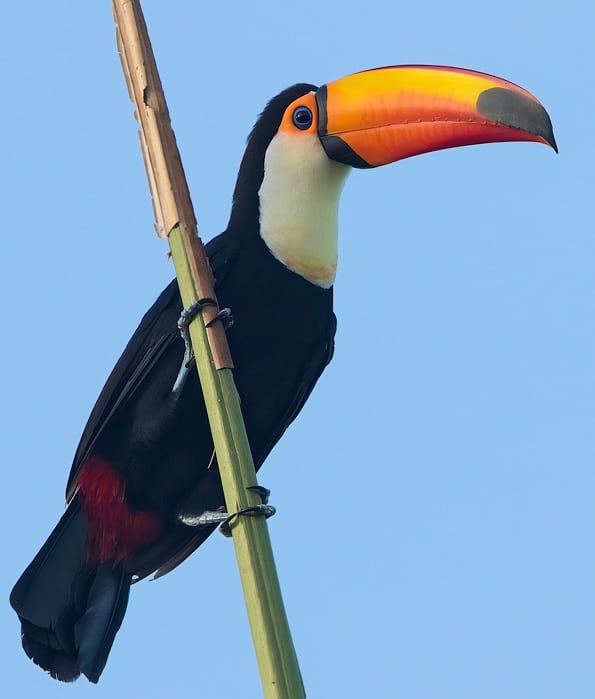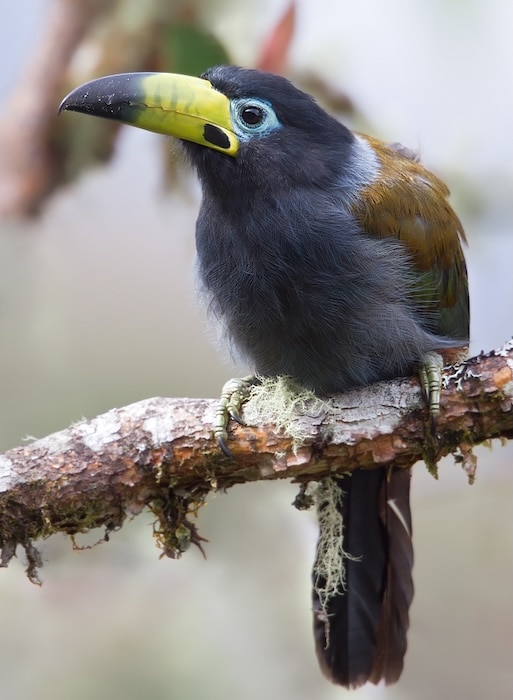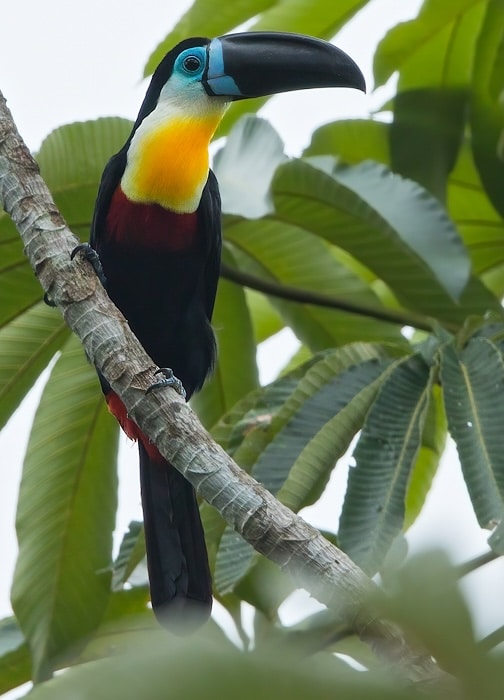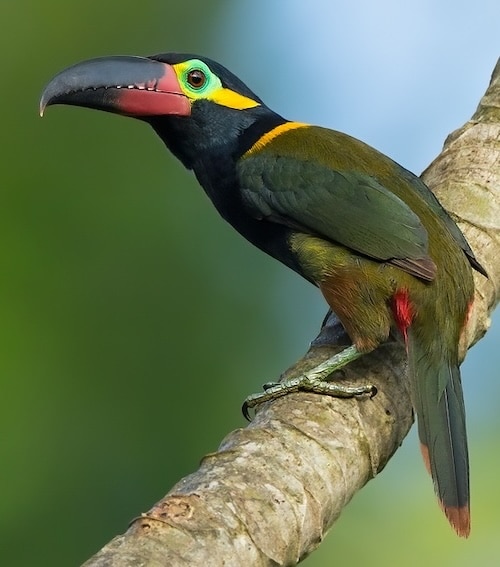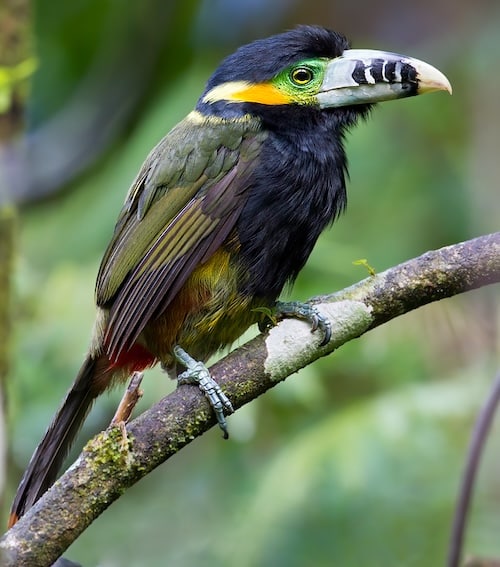Ramphastidae – Aracari, Toucans & Toucanets

The Ramphastidae or Toucans are members of a family of near passerine birds from the Neotropics. They form part of the order Piciformes, along with Lybiidae (African Barbets), Megalaimidae (Asian Barbets), Capitonidae (New World Barbets), Semnornithidae (Toucan-barbets), Indicatoridae (Honeyguides) and Picidae (Woodpeckers). They are most closely related to the American barbets. They are brightly marked and have large, often colourful bills. The family includes five genera and over forty different species.
|
|
|
|
Keel-billed Toucan Ramphastos sulfuratus |
Toco Toucan Ramphastos toco |
|
|
|
|
Hooded Mountain Toucan Andigena cucullata |
Channel-billed Toucan Ramphastos vitellinus |
|
All Photos in this text ©Dubi Shapiro |
|
Toucans range in size from the Lettered Aracari at 130g and 29cm to the Toco Toucan at 680g and 63cm. Their bodies are short (of comparable size to a crow’s) and compact. The tail is rounded and varies in length, from half the length to the whole length of the body. The neck is short and thick. The wings are small, as they are forest-dwelling birds who only need to travel short distances, and are often of about the same span as the bill-tip-to-tail-tip measurements of the bird.
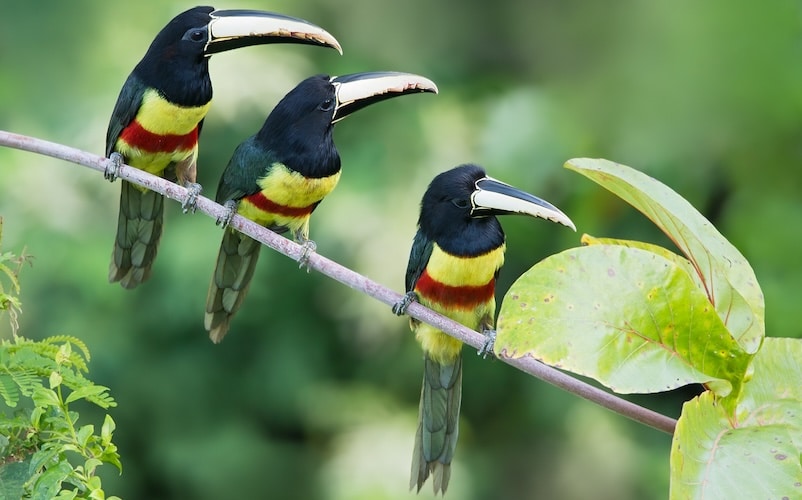
Black-necked Aracaris Pteroglossus aracari
Their legs are strong and rather short. Their toes are arranged in pairs with the first and fourth toes turned backward. The majority of toucans do not show any sexual dimorphism in their coloration, the genus Selenidera being the most notable exception to this rule (hence their common name, ‘dichromatic toucanets’). However, the bills of female toucans are usually shorter, deeper and sometimes straighter, giving more of a ‘blocky’ impression compared to male bills. The feathers in the genus containing the largest toucans are generally black, with touches of white, yellow, and scarlet. The underparts of the araçaris (smaller toucans) are yellow, crossed by one or more black or red bands. The toucanets have mostly green plumage with blue markings.
|
|
|
|
Guianan Toucanet Selenidera piperivora |
Saffron Toucanet Pteroglossus bailloni |
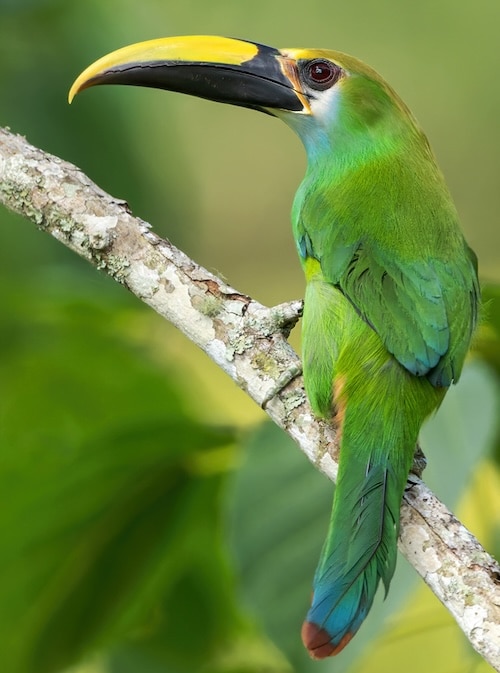
|
|
|
Emerald Toucanet Aulacorhynchus prasinus wagleri |
Spot-billed Toucanet Selenidera maculirostris |
The colourful and large bill, which in some large species measures more than half the length of the body, is the hallmark of toucans. Despite its size, the toucan’s bill is very light, being composed of bone struts filled with spongy tissue of keratin between them. The bill has forward-facing serrations resembling teeth, which historically led naturalists to believe that toucans captured fish and were primarily carnivorous; today it is known that they eat mostly fruit. Researchers have discovered that the large bill of the toucan is a highly efficient thermoregulation system, though its size may still be advantageous in other ways. It does aid in their feeding behaviour (as they sit in one spot and reach for all fruit in range, thereby reducing energy expenditure), and it has also been theorised that the bill may intimidate smaller birds, so that the toucan may plunder nests undisturbed. Also, the beak allows the bird to reach deep into tree-holes to access food unavailable to other birds, and also to ransack suspended nests built by smaller birds. However, as there is no sexual dimorphism in coloration it is unlikely to be a sexual signal.

Crimson-rumped Toucanet Aulacorhynchus haematopygus
A toucan’s tongue is long (up to 14cm or 15cm), narrow, grey, and singularly frayed on each side, adding to its sensitivity as an organ of taste.
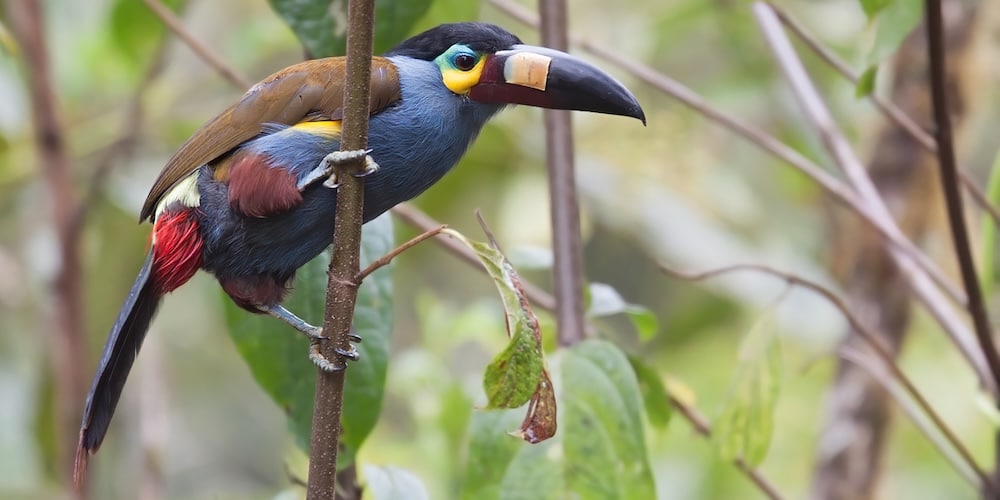
Plate-billed Mountain Toucan Andigena laminirostris
A structural complex probably unique to toucans involves the modification of several tail vertebrae. The rear three vertebrae are fused and attached to the spine by a ball and socket joint. Because of this, toucans may snap their tail forward until it touches the head. This is the posture in which they sleep, often appearing simply as a ball of feathers, with the tip of the tail sticking out over the head.
Green-billed Toucan Ramphastos dicolorus
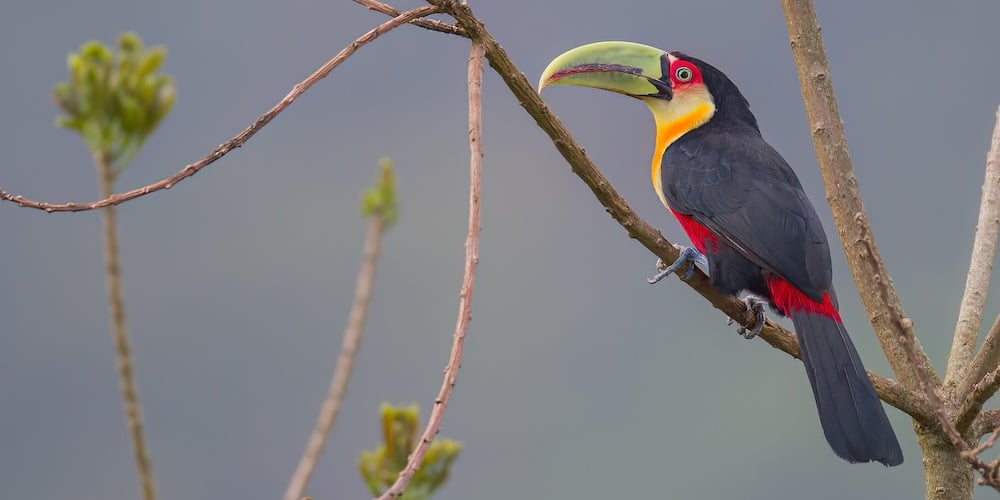
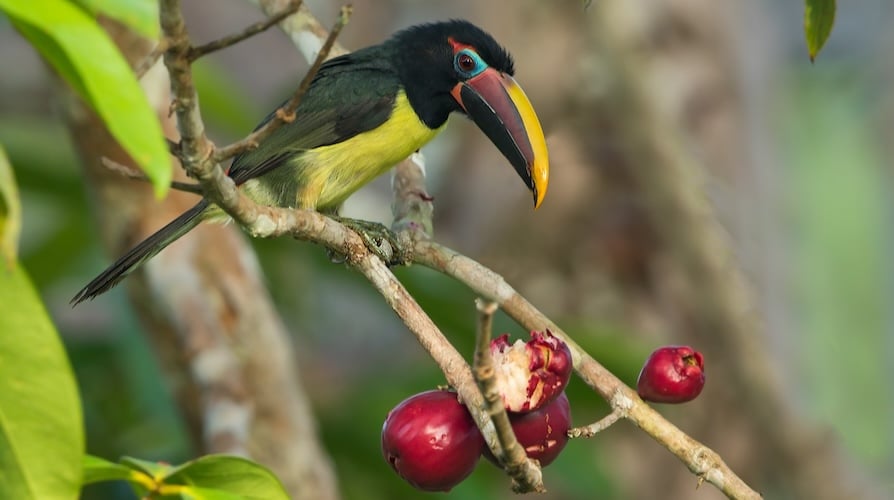
Green Aracari Pteroglossus viridis
Toucans are primarily frugivorous (fruit eating), but are opportunistically omnivorous and will take prey such as insects and small lizards. Captive toucans have been reported to hunt insects actively in their cages, and it is possible to keep toucans on an insect-only diet. They also plunder nests of smaller birds, taking eggs and nestlings.
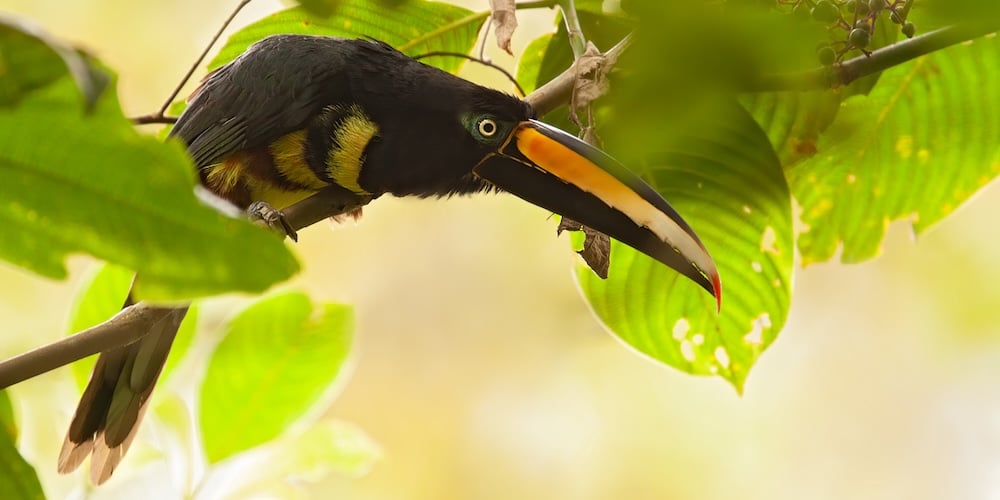
Many-banded Aracari Pteroglossus pluricinctus
This probably provides a crucial addition of protein to their diet. Certainly, apart from being systematically predatory as well as frugivorous, like many omnivorous birds, they particularly prefer animal food for feeding their chicks. However, in their range, toucans are the dominant frugivores, and as such, play an extremely important ecological role as vectors for seed dispersal of fruiting trees.
-
Number of bird species: 37
(As at September 2025)
There are, according to the newly (2025) combined AviList, thirty-seven species of Toucans and Toucanets & Aracaris in five genera in the family Ramphastidae. They are:
Toco Toucan Ramphastos toco
Yellow-throated Toucan Ramphastos ambiguus
White-throated Toucan Ramphastos tucanus
Keel-billed Toucan Ramphastos sulfuratus
Choco Toucan Ramphastos brevis
Channel-billed Toucan Ramphastos vitellinus
Green-billed Toucan Ramphastos dicolorus
Saffron Toucanet Pteroglossus bailloni
Green Aracari Pteroglossus viridis
Lettered Aracari Pteroglossus inscriptus
Collared Aracari Pteroglossus torquatus
Fiery-billed Aracari Pteroglossus frantzii
Black-necked Aracari Pteroglossus aracari
Chestnut-eared Aracari Pteroglossus castanotis
Many-banded Aracari Pteroglossus pluricinctus
Ivory-billed Aracari Pteroglossus azara
Curl-crested Aracari Pteroglossus beauharnaisii
Red-necked Aracari Pteroglossus bitorquatus
Pale-mandibled Aracari Pteroglossus erythropygius
Emerald Toucanet Aulacorhynchus prasinus
White-throated Toucanet Aulacorhynchus albivitta
Groove-billed Toucanet Aulacorhynchus sulcatus
Chestnut-tipped Toucanet Aulacorhynchus derbianus
Tepui Toucanet Aulacorhynchus whitelianus
Crimson-rumped Toucanet Aulacorhynchus haematopygus
Yellow-browed Toucanet Aulacorhynchus huallagae
Blue-banded Toucanet Aulacorhynchus coeruleicinctis
Grey-breasted Mountain Toucan Andigena hypoglauca
Plate-billed Mountain Toucan Andigena laminirostris
Hooded Mountain Toucan Andigena cucullata
Black-billed Mountain Toucan Andigena nigrirostris
Yellow-eared Toucanet Selenidera spectabilis
Guianan Toucanet Selenidera piperivora
Golden-collared Toucanet Selenidera reinwardtii
Tawny-tufted Toucanet Selenidera nattereri
Gould’s Toucanet Selenidera gouldii
Spot-billed Toucanet Selenidera maculirostris
-
Channel-billed Toucan - A Photographic and Artistic Vision
| By José Felipe Monteiro Pereira | JF Editoraves | 2013 | Paperback | 91 pages, colour photos | ISBN: 9788590936886 Buy this book from NHBS.com -
Toucans, Barbets and Honeyguides
| By Lester Short , A E Gilbert & Jennifer Horne | Illustrat Earl Gilbert | Oxford University Press | 2001 | Hardback | 526 pages, 36 col plates, col photos, illus, maps | ISBN: 780198546665 Buy this book from NHBS.com
-
Ramphastidae
Family AccountSmall to medium-sized non-passerines with enormous and colorfully patterned bills, toucans have become familiar to many through their frequent appearance... -
Ramphastidae
Family AccountToucans are Neotropical birds in the family Ramphastidae. They are most closely related to the Toucan barbets.
Given the number of species in this family, Fatbirder does not provide quick links to all of them. However, the entries below do include links to representatives of every genera, all those illustrated and some of the most often encountered, iconic or sought-after species.
-
Black-necked Aracari Pteroglossus aracari
Species AccountMulticolored aracari with a black head, an olive-green back, and a bicolored bill: pale above and black below. -
Black-necked Aracari Pteroglossus aracari
Species AccountSound archive and distribution map. -
Blue-banded Toucanet Aulacorhynchus coeruleicinctis
Species AccountThe blue-banded toucanet (Aulacorhynchus coeruleicinctis) is a near-passerine bird in the toucan family Ramphastidae. It is found in Bolivia and Peru. -
Blue-banded Toucanet Aulacorhynchus coeruleicinctis
Species AccountSound archive and distribution map. -
Channel-billed Toucan Ramphastos vitellinus
Species AccountLarge toucan, widespread across South American lowlands. Mostly black with a dark bill (although some populations have a yellow ridge on top of the bill). -
Channel-billed Toucan Ramphastos vitellinus
Species AccountThe channel-billed toucan (Ramphastos vitellinus) is a near-passerine bird in the family Ramphastidae found in Trinidad and in tropical South America as far south as southern Brazil and central Bolivia. -
Channel-billed Toucan Ramphastos vitellinus
Species AccountRamphastos vitellinus is listed as Least Concern. -
Channel-billed Toucan Ramphastos vitellinus
Species AccountSound archive and distribution map. -
Collared Aracari Pteroglossus torquatus
Species AccountAn attractive small toucan of tropical lowland forest and edge. Usually found in small groups moving through the canopy of fruiting trees or seen flying. -
Collared Aracari Pteroglossus torquatus
Species AccountThe collared aracari or collared araçari (Pteroglossus torquatus) is a toucan, a near-passerine bird. It breeds from southern Mexico to Panama; also Ecuador, Colombia, Venezuela and Costa Rica. -
Collared Aracari Pteroglossus torquatus
Species AccountSound archive and distribution map. -
Crimson-rumped Toucanet Aulacorhynchus haematopygus
Species AccountThe crimson-rumped toucanet (Aulacorhynchus haematopygus) is a near-passerine bird in the toucan family Ramphastidae. -
Crimson-rumped Toucanet Aulacorhynchus haematopygus
Species AccountSound archive and distribution map. -
Emerald Toucanet Aulacorhynchus prasinus
Species AccountMedium-sized, grass-green toucan of humid tropical forest in foothills and highlands; also very locally in lowlands. Usually in pairs or small groups... -
Emerald Toucanet Aulacorhynchus prasinus
Species AccountSound archive and distribution map. -
Fiery-billed Aracari Pteroglossus frantzii
Species AccountAracaris are medium-sized toucans, rather slender and long tailed. Fiery-billed is distinctive: the top half of the bill is bright orange. -
Fiery-billed Aracari Pteroglossus frantzii
Species AccountThe fiery-billed aracari or fiery-billed araçari is a toucan, a near-passerine bird. It breeds only on the Pacific slopes of southern Costa Rica and western Panama. The binomial commemorates the German naturalist Alexander von Frantzius. -
Fiery-billed Aracari Pteroglossus frantzii
Species AccountSound archive and distribution map. -
Green Aracari Pteroglossus viridis
Species AccountCommon small toucan of rainforest canopy. The key field mark is the clear yellow belly that contrasts sharply with a dark breast. -
Green Aracari Pteroglossus viridis
Species AccountSound archive and distribution map. -
Green-billed Toucan Ramphastos dicolorus
Species AccountThe red-breasted toucan or green-billed toucan (Ramphastos dicolorus) is a bird in the family Ramphastidae, the toucans, toucanets, and aracaris. -
Green-billed Toucan Ramphastos dicolorus
Species AccountSound archive and distribution map. -
Groove-billed Toucanet Aulacorhynchus sulcatus
Species AccountThe groove-billed toucanet (Aulacorhynchus sulcatus) is a near-passerine bird in the toucan family Ramphastidae. It is found in Colombia and Venezuela. -
Groove-billed Toucanet Aulacorhynchus sulcatus
Species AccountSound archive and distribution map. -
Guianan Toucanet Selenidera piperivora
Species AccountSmall toucan of rainforest canopy that is most often seen at fruiting trees at forest edge. Smaller than an aracari and tends not to occur in large groups. -
Guianan Toucanet Selenidera piperivora
Species AccountSound archive and distribution map. -
Hooded Mountain Toucan Andigena cucullata
Species AccountBeautiful toucan of Andean cloud forest that is found mainly in Bolivia, though it also reaches far southeastern Peru. Very colorful, with greenish wings. -
Hooded Mountain Toucan Andigena cucullata
Species AccountSound archive and distribution map. -
Keel-billed Toucan Ramphastos sulfuratus
Species AccountThe keel-billed toucan (Ramphastos sulfuratus), also known as sulfur-breasted toucan or rainbow-billed toucan, is a colorful Latin American member of the toucan family. It is the national bird of Belize -
Keel-billed Toucan Ramphastos sulfuratus
Species AccountSound archive and distribution map. -
Many-banded Aracari Pteroglossus pluricinctus
Species AccountFairly small toucan found in northwestern Amazonia. Often the most common speices of aracari within its range. -
Many-banded Aracari Pteroglossus pluricinctus
Species AccountSound archive and distribution map. -
Plate-billed Mountain Toucan Andigena laminirostris
Species AccountExtraordinary and iconic toucan of Andean cloud forest in northwestern Ecuador, just barely reaching southwestern Colombia. -
Plate-billed Mountain Toucan Andigena laminirostris
Species AccountSound archive and distribution map. -
Saffron Toucanet Pteroglossus bailloni
Species AccountThe saffron toucanet (Pteroglossus bailloni) is a species of bird in the family Ramphastidae found in the Atlantic Forest in far north-eastern Argentina -
Saffron Toucanet Pteroglossus bailloni
Species AccountSound archive and distribution map. -
Spot-billed Toucanet Selenidera maculirostris
Species AccountSmall multicolored toucan with an olive-green back, bare blue skin around the eyes, a red vent, and a chestnut-tipped green tail. -
Spot-billed Toucanet Selenidera maculirostris
Species AccountSound archive and distribution map. -
Toco Toucan Ramphastos toco
Species AccountThe toco toucan (Ramphastos toco) is a species of bird in the toucan family Ramphastidae. It is the largest species of toucan and has a distinctive... -
Toco Toucan Ramphastos toco
Species AccountSound archive and distribution map. -
Yellow-eared Toucanet Selenidera spectabilis
Species AccountThe yellow-eared toucanet (Selenidera spectabilis) is a near-passerine bird in the toucan family Ramphastidae. It is found from Honduras to Ecuador. -
Yellow-eared Toucanet Selenidera spectabilis
Species AccountSound archive and distribution map. -
Yellow-throated Toucan Ramphastos ambiguus
Species AccountThe yellow-throated toucan (Ramphastos ambiguus) is a large toucan in the family Ramphastidae found in Central and northern South America. -
Yellow-throated Toucan Ramphastos ambiguus
Species AccountRamphastos ambiguus is listed as Least Concern. -
Yellow-throated Toucan Ramphastos ambiguus
Species AccountSound archive and distribution map.


